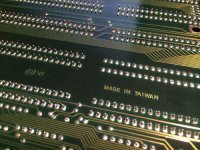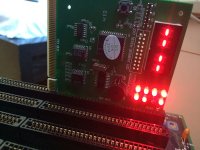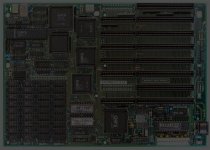Hi Henrik,
There's another 4-pin J7 which might be for the speaker. Also I notice a bit of corrosion below the battery, maybe make sure everything is clean and there are no broken corroded traces around there.
You could try checking if J2 is connected to the battery connectors, and connect three 1.2V cells to it, maybe it needs a battery to POST. Or connect them to the old battery connectors directly.
Aside from these Henrik, sounds like you've tried just about everything.....

I surely don't know everything, other members might have some other ideas, but at this point Henrik I'd throw in the towel. Sometimes motherboards just go 'dud' for no visible reason.
To illustrate, let me cite a particularly weird example that just happened to me a few months ago.
Last year I found a big Dell Xeon server at my dump, booted it up a dozen times worked perfect. I listed it on Kijiji for fun and stored it away. Early this year I got a good offer on it, I got it out and booted it up to make sure it still worked before shipping it. Again worked perfect, turned it on and off a few times, and shut it down for the day.
Next day I turned it on, dead no POST, zero nada. I tried everything, swapped CPU, RAM, unplugged everything, removed the whole board. Whatever I did I NEVER got it to boot up again. It was just working 12hrs before, shutdown one night, next day dead, no changes or anything - really tearing my hair out!
Fortunately it worked out for me, I managed to find a new replacement board on eBay and got it shipped up and installed it while still making a very good profit, was lucky.
Anyway, my point is sometimes they just go bad, probably a tiny component responsible for the board powering up is bad, and good luck finding it. I noticed while I was debugging my Dell board that after a while the Power LED stopped lighting up, probably a clue but who knows, only 100 million parts to check lol. My Dad says all these transistors, which are really crystalline structures, do not like shock. The Dell had gotten thrown, so I guess something was cracked and finally failed. Who knows what your 286 board has bounced through the past 25 years or so, static damage etc etc.....:D
Hope this makes you feel better Henrik, you're not alone......

All the best,
Bellarmine





